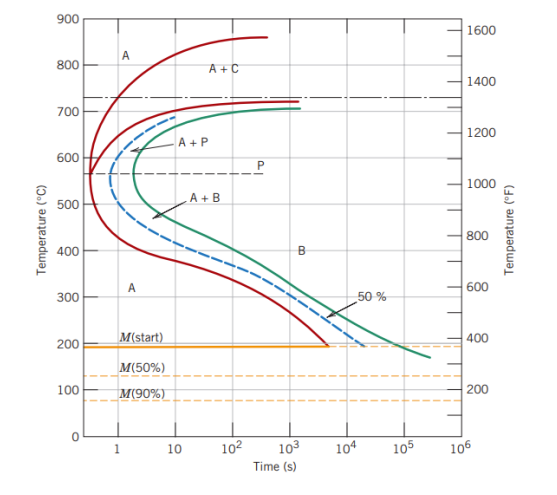Using the isothermal transformation diagram for a 1.13 wt% C steel alloy, determine the final microstructure (in terms of the microconstituents present) of a small specimen that has undergone the following time-temperature treatments. In each case suppose that the sample begins at 920 ° C and that it has been held at this temperature for the time sufficient to achieve a complete and homogeneous austenitic structure. (a) Quickly cool to 250 ° C, hold for 103 s, then cool to room temperature. (b) Quickly cool to 400 ° C, hold for 500 s, then cool to room temperature. (c) Quick cool to 700 ° C, hold for 105 s, then cool to room temperature. (d) Rapidly cool to 650 ° C, hold for 3 s and rapidly cool to 400 ° C, hold that temperature for 25 s and cool to room temperature. (e) Quick cool to 650 ° C, hold for 7 s, then cool to room temperature.
Using the isothermal transformation diagram for a 1.13 wt% C steel alloy, determine the final microstructure (in terms of the microconstituents present) of a small specimen that has undergone the following time-temperature treatments. In each case suppose that the sample begins at 920 ° C and that it has been held at this temperature for the time
sufficient to achieve a complete and homogeneous austenitic structure.
(a) Quickly cool to 250 ° C, hold for 103 s, then cool to room temperature.
(b) Quickly cool to 400 ° C, hold for 500 s, then cool to room temperature.
(c) Quick cool to 700 ° C, hold for 105 s, then cool to room temperature.
(d) Rapidly cool to 650 ° C, hold for 3 s and rapidly cool to 400 ° C, hold that temperature for 25 s and cool to room temperature.
(e) Quick cool to 650 ° C, hold for 7 s, then cool to room temperature.

Trending now
This is a popular solution!
Step by step
Solved in 3 steps with 1 images


